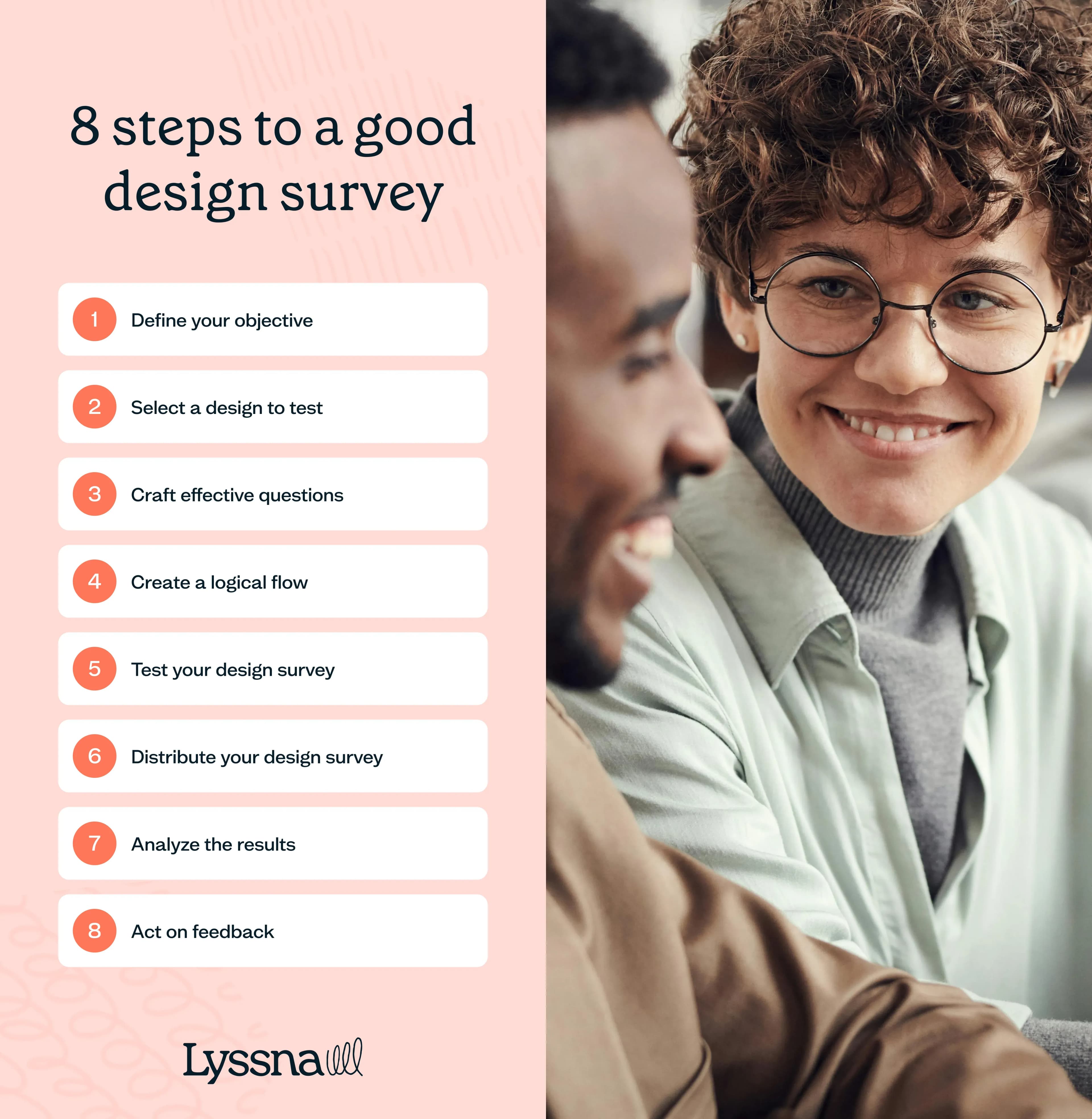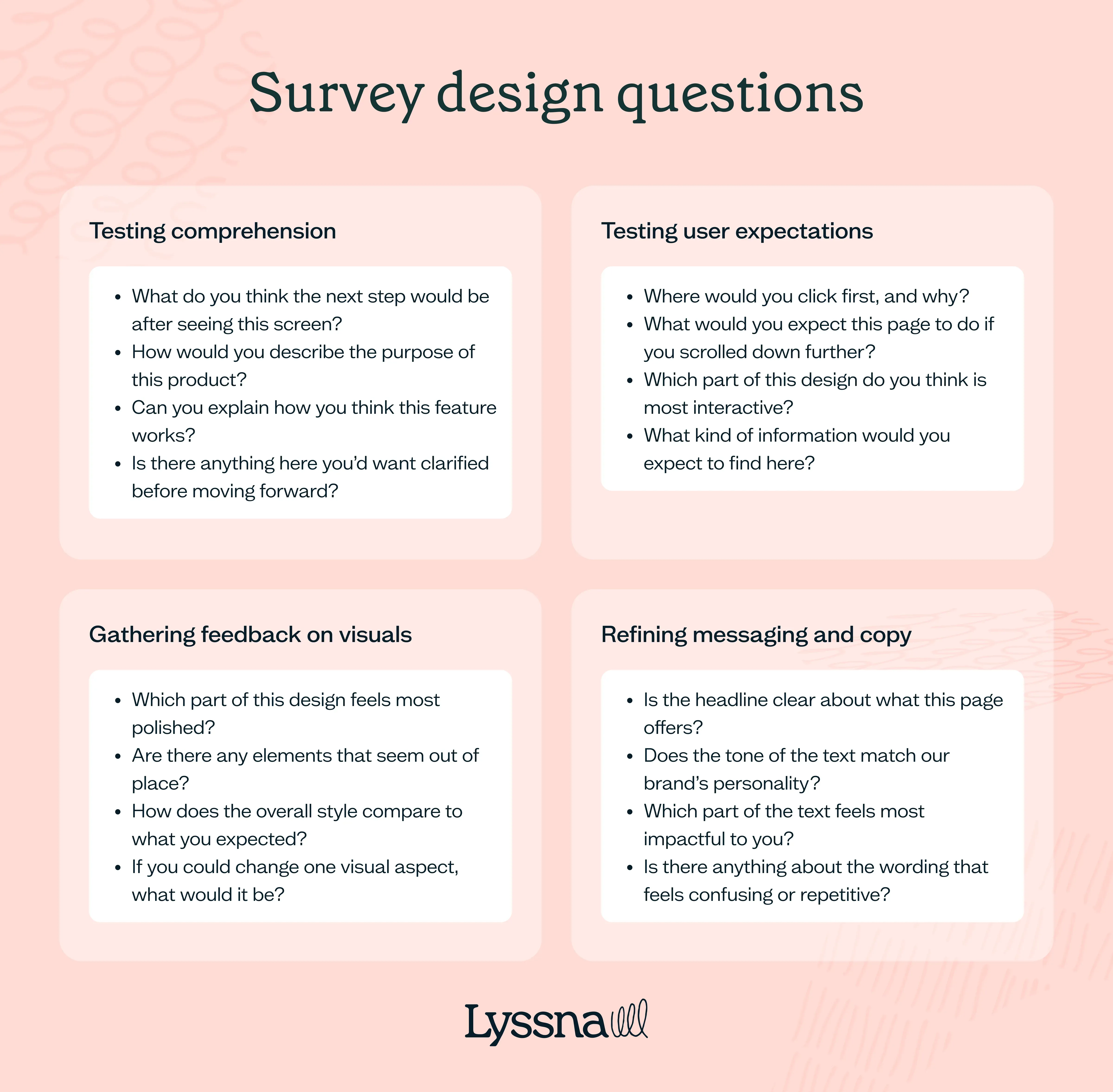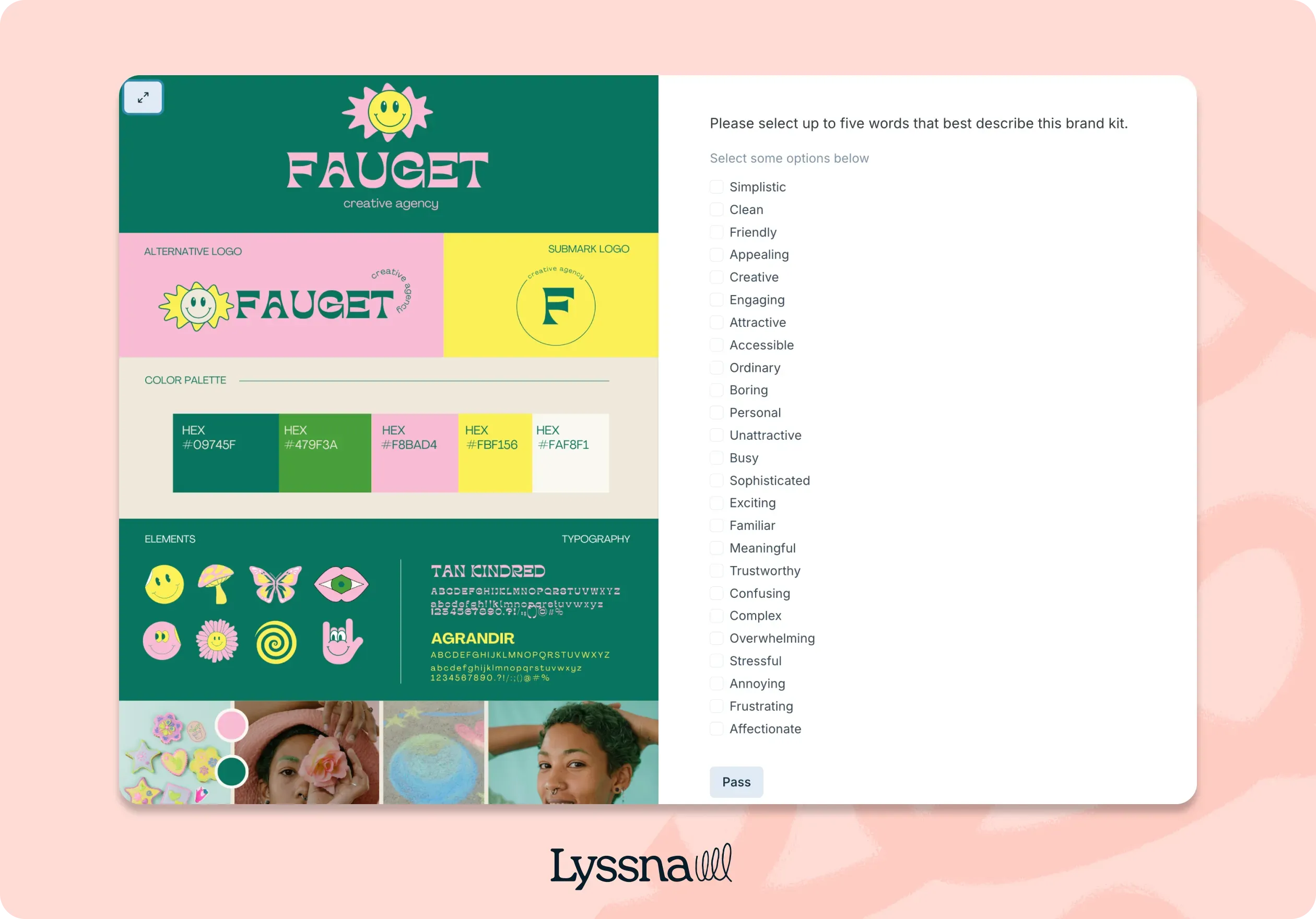Design surveys guide
Want to know if your design actually works? Stop guessing. Start asking. A design survey is like a feedback super-tool. It puts your design – whether it’s a webpage, logo, or video – front and center while users respond in real-time. And, because you’re showing the design as you ask the questions, every answer is grounded in context. No more vague “Hmm....I'm not sure I like it” feedback. Just sharp, focused feedback that helps you iterate with clarity and speed.
Design surveys guide: Benefits & methods for UX feedback
5 benefits of design surveys for UX feedback
Design surveys are a powerful way to gather meaningful user feedback, helping you improve your designs with confidence. Here are five key benefits.
1. Gathers in-depth feedback with context
In Lyssna, design surveys let participants view your design, watch your video, or listen to your audio as they answer questions, giving their feedback immediate context. For instance, you can test whether a pricing page explains its value effectively or if a landing page highlights the right features. This direct connection between the design and the questions ensures specific, practical feedback.
2. Enables thoughtful and detailed responses
Rushed feedback rarely tells the full story. Design surveys give participants the time they need to reflect and respond. This makes them perfect for assessing elements like functionality, layout, or overall appeal. Imagine testing a new concept. Instead of snap judgments, you’d get a deeper understanding of how users interpret the idea.
3. Supports multimedia feedback
Design surveys aren’t just for static images. They handle videos, animations, and audio clips just as easily. Testing an animation for social media? You can find out if the call to action grabs attention. Rolling out a teaser video? Check whether the pacing keeps viewers engaged. No matter the format, design surveys give you the flexibility to test and refine creative work across all kinds of media.
4. Uses diverse question styles
A good survey goes beyond simple yes/no answers. Design surveys let you use multiple formats – like open text, multiple-choice, ranking, or linear scales – to dig deeper. You might ask, “What stands out most in this design?” or “How would you rate the clarity of this message?” With tailored questions, you’ll get feedback that directly links to your design’s strengths and areas for improvement.
Check out this article to find out the types of questions you can ask in a design survey.
5. Scales with multiple design variations
Why settle for testing one design at a time? Design surveys let you compare multiple concepts in a single study. Imagine running a survey for two home page designs – you can quickly find out which layout users find more intuitive. This approach saves time, keeps your process efficient, and helps you zero in on the best version of your work.
What can you learn from design surveys?
Design surveys are a direct line to your users, helping you uncover feedback that you can’t easily get from other methods. Whether you’re clarifying a message, exploring user expectations, or refining creative work, here’s how you can use them to sharpen your designs.
Testing comprehension
Good design doesn’t just look good – it communicates. With design surveys, you can find out if users understand what they’re seeing. Test whether a pricing page communicates its value or if a logo aligns with your brand’s identity. Ask questions like, “What do you think this page is for?” or “Is there anything confusing here?” to uncover where your design falls short.
This approach works especially well when you’re fine-tuning messaging on key pages or ensuring early-stage designs are clear and effective.
Testing user expectations
Your design may look polished, but does it meet your users’ expectations? Use design surveys to ask questions like, “What do you expect to happen if you click this button?” or “What do you think is clickable on this page?” These questions reveal whether your design’s affordance – those subtle visual cues that signal how elements work – aligns with what users assume.
You can use this method to improve new features, interactive prototypes, or any element where usability needs to feel intuitive.
Design surveys as follow-ups
One test rarely tells the whole story. Pair a five second test with a design survey to dig deeper. For example, use a quick recall test to measure first impressions, then follow up with a design survey to explore deeper. Questions like, “What stands out most to you now?” or “Does this design feel trustworthy?” help you gauge both snap judgments and more thoughtful responses.
This method works well for branding or logo concepts, where you need to balance impact with deeper resonance.
Testing dynamic content
You’ve poured hours into crafting a slick promotional video – but does it grab your audience, or are they zoning out halfway through, mentally drafting their grocery list?
Dynamic content is tricky because pacing, visuals, sound, and messaging all need to harmonize seamlessly. Design surveys help you uncover how well your videos will land. With actionable feedback, you can fine-tune every detail and deliver an experience that leaves a lasting impression.
Start gathering design feedback today
Ready to understand how users really feel about your designs? Start collecting the feedback you need with Lyssna to make confident design decisions.
8 steps to a good design survey
Creating a well-designed survey isn’t just about writing questions (though that’s a good start) – it’s about ensuring the entire process is smooth, clear, and engaging for your participants. Follow these steps to create design surveys that gathers meaningful feedback and keep your participants invested.

1. Define your objective
Start by asking yourself: What do I need to learn from this survey? Whether you’re testing comprehension, user expectations, or branding, having a clear goal will help you craft focused questions and get actionable results.
2. Select a design to test
Choose the specific design or variation you want to gather feedback on. It could be a web page, logo, or even a video. Make sure the design is ready to be showcased – clear, high-quality visuals are a must.
3. Craft effective questions
Write survey questions that are easy to understand and directly tied to your objective. Use a mix of open-ended, multiple-choice, and ranking questions to get both qualitative and quantitative feedback. This balance is key, and understanding the difference between quantitative vs qualitative research will help you decide which question types support your goals best.
4. Create a logical flow
Organize your questions in a natural sequence. Start broad – first impressions or general reactions – and then move into more detailed questions about specific elements like color schemes, messaging, or functionality. A well-organized survey keeps participants focused and prevents fatigue.
5. Test your design survey
Before sending it out, preview your survey as a participant. Look for confusing instructions, fuzzy phrasing, or technical glitches. Testing ensures the survey experience is smooth and professional.
6. Distribute your design survey
Decide how you’ll share your survey. Use your own network or tap into a participant panel to reach your target audience. Make sure your survey is mobile-friendly and easy to access on any device.
7. Analyze the results
Once the responses are in, look for patterns and outliers. What stands out? Does the feedback confirm your assumptions, or does it highlight areas for improvement? Tagging and categorizing responses helps you identify recurring and relevant themes.
8. Act on feedback
Turn your findings into action. Use your knowledge to refine your design, improve messaging, or create new variations. If there are unresolved questions, consider a follow-up survey to dig deeper.
Survey design questions
Great surveys start with great questions. The trick isn’t just knowing what to ask – it’s knowing how to ask it, and understanding how your questions relate to different qualitative research methods. Here are some fresh, practical examples to get you thinking – and asking – like a pro.

Testing comprehension
What do you think the next step would be after seeing this screen?
How would you describe the purpose of this product?
Can you explain how you think this feature works?
Is there anything here you’d want clarified before moving forward?
Testing user expectations
Where would you click first, and why?
What would you expect this page to do if you scrolled down further?
Which part of this design do you think is most interactive?
What kind of information would you expect to find here?
Gathering feedback on visuals
Which part of this design feels most polished?
Are there any elements that seem out of place?
How does the overall style compare to what you expected?
If you could change one visual aspect, what would it be?
Refining messaging and copy
Is the headline clear about what this page offers?
Does the tone of the text match our brand’s personality?
Which part of the text feels most impactful to you?
Is there anything about the wording that feels confusing or repetitive?
Our 7 top tips for design surveys
Design surveys are a powerful way to gather user feedback, but your approach can make or break your results. Follow these tips to get the most value from your surveys.
1. Keep questions clear and concise
Avoid overwhelming your participants with long, complicated questions. Focus on simple, straightforward language that’s easy to understand. Clear questions lead to clearer answers.
2. Use a mix of question types
Combine open-ended, multiple-choice, and ranking questions to get a balance of qualitative and quantitative feedback, each aligning with different types of quantitative studies to ensure your results are both insightful and measurable. For example, “What stands out most in this design?” alongside a question like, “How would you rate the clarity of this message?”
3. Ask about key design aspects
Focus your questions on specific elements you want feedback on, such as layout, color, typography, or messaging. This keeps the survey targeted and the feedback relevant.
4. Test multiple design variations (if needed)
If you’re deciding between different design versions, include multiple variations in your survey. Ask participants to compare them and share their preferences. This helps you make data-backed design decisions.
5. Avoid leading or biased questions
Ah yes, the favorite of grandstanding TV lawyers – leading questions. They might win over a jury on TV screens, but they only muddy the results from yours. Instead of asking, “Doesn’t this layout feel intuitive?”, try something neutral like, “How easy is it to navigate this layout?” You might not get a unanimous verdict, but you’ll get a fairer one.
6. Include context and instructions at the beginning
Set participants up for success by explaining the purpose of the survey and what they’ll be reviewing. Provide any necessary context or background about the design. Clear instructions make it easier for participants to give meaningful feedback.
7. Use logic to customize the survey experience
Survey logic allows you to tailor the experience based on participants’ previous answers. Say a participant indicates they’re confused by a section, you can show follow-up questions to dig deeper. This keeps the survey relevant and efficient.

Design surveys are a great way to gather feedback from your target audience about your designs.
Final thoughts and how Lyssna can help
Design surveys are more than just a way to collect feedback – they’re a bridge between your creative vision and your users’ experiences, and a practical approach to effective design validation testing. By using them thoughtfully, you can uncover exactly how your designs resonate with your audience, whether clarifying a product page, refining messaging, or testing new features.
At Lyssna, we make it easy to integrate design surveys into your workflow. Our platform allows you to:
Upload high-quality visuals, videos, or audio to keep your designs front and center during feedback.
Ask targeted questions with a variety of formats – from open-ended questions to scales and multiple-choice options.
Combine design surveys with other tests like five second or first click tests to get a complete picture of user responses.
Access a diverse participant panel, with detailed targeting across 395+ attributes, to guarantee you’re gathering data from the right audience.
Whether you’re a UX researcher, designer, product manager, or marketer, Lyssna’s tools are designed to help you move faster and make decisions with confidence.
Turn design feedback into action
Stop guessing what users think about your designs. Get started with Lyssna and gather the meaningful feedback you need to create experiences users love.


